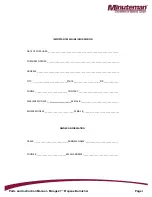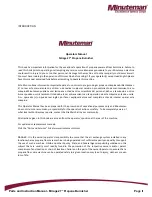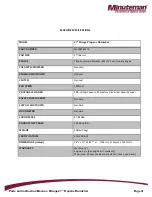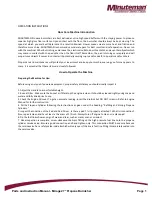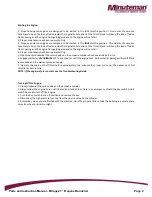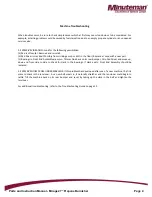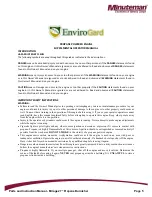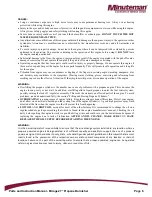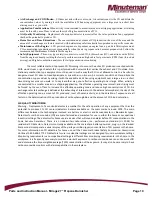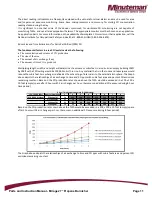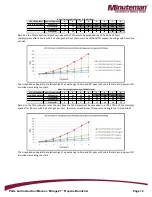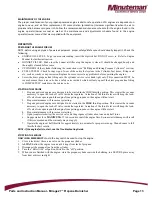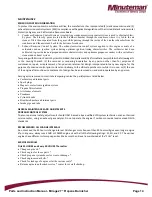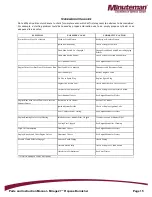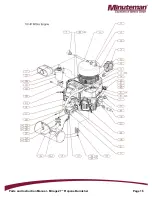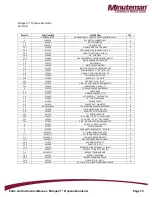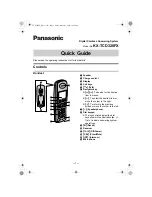
Parts and Instruction Manual -
Mirage 27” Propane Burnisher
Page 8
REFILLING & STORING PROPANE CYLINDERS
The NFPA Technical Committee prohibits the storage of such containers in buildings. There are few exceptions to
this rule. In other words, propane cylinders should NOT be stored in buildings used by the public or frequented by
anyone passing through or who is working in the building. Full or empty, never leave cylinders in small enclosed
areas. The cylinder(s) must be in a secure, tamper-proof storage enclosure that provides safety from accident or
vandalism.
PROPANE CYLINDERS SHOULD ALWA
YS
BE TRANSPORTED, INSTALLED AND USED IN AN UPRIGHT
POSITION. OVERFILLING PROPANE CYLINDERS IS HAZARDOUS.
The cylinder should
NEVER
be completely filled with
liquid propane. 80% of the total cylinder volume is to be considered at
ALL
times as full.
EXPANSION MUST BE
ALLOWED FOR.
Propane Powered engine cylinders are equipped with a fixed liquid level gauge which contacts the
liquid level at 80% of container capacity, allowing 20% for expansion. The top part of this device must be unscrewed
counterclockwise so that vapor can escape through the small hole it its side, as the cylinder is refilled. When the
escaping vapor starts to give way to liquid, the device must be quickly closed and the propane nozzle turned off.
WARNING:
The engine and the fuel system on your propane powered engine are designed to run on propane vapor, not propane
liquid. Overfilling the propane cylinder will result in damaging the lock off
and/or
regulator. This will
VOID
the
WARRANTY
on these components.
ENGINE EMISSIONS AND CO SAFETY
The purpose of this document is to provide information on:
The potential effects of CO exposure
The methods to reduce the risk of CO poisoning
All LPG (Liquid Propane Gas) powered engines, including this engine, produce Carbon Monoxide (CO). It is a
FATAL POISON that is a colorless, odorless, tasteless, and non-irritating gas. It is produced by incomplete
combustion of carbonaceous material such as propane (LPG). Failure to provide for proper venting of CO produced
during the operation of combustion powered engines may result in SERIOUS INJURY OR DEATH to the operator
and those in the contaminated area. The effects of CO can be experienced at different exposure levels, depending
on the health of the individual. Conditions that affect the tolerance of the individual are smoking, age, temperature,
humidity, and other conditions.
WARNING:
Read and understand The Operators Manual completely before using this engine. This document explains how CO
produced can be managed to reduce the risk of carbon monoxide poisoning. All distributors, owners, and operators
should be aware of the potential effects of CO and the methods used to prevent overexposure. We are dedicated to
our customers, their safety, and providing information, services, and products that meet those needs. Information
provided in this document is current as of the date written January 2013.
SUMMARY
POTENTIAL EFFECTS OF CO EXPOSURE
The information provided in the following overview has been condensed to provide the reader with a summary of
the material presented.
Work place/industry guidelines for CO exposure limits vary substantially from region to region (OSHA) Permissible
Exposure Limit (PEL) for CO is 50 ppm, as an 8-hour time weighted average.
Definition of CO effects - The toxic effects of carbon monoxide in the blood is the result of tissue hypoxia (lack of
oxygen). The severity depends on the state of activity of the individual and his tissue oxygen needs.
WORK PLACE/INDUSTRY GUIDELINES FOR CO EXPOSURE LIMITS
Summary of Contents for Mirage 27"
Page 1: ...Parts and Instruction Manual Mirage 27 Propane Burnisher ...
Page 23: ...Parts and Instruction Manual Mirage 27 Propane Burnisher Page 16 ...
Page 25: ...Parts and Instruction Manual Mirage 27 Propane Burnisher Page 18 ...
Page 28: ...Parts and Instruction Manual Mirage 27 Propane Burnisher Page 21 ...
Page 29: ...Parts and Instruction Manual Mirage 27 Propane Burnisher Page 22 Notes ...


